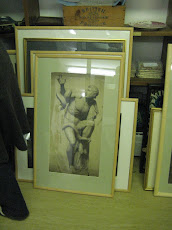A warning to scholars writing or thinking about Evelyn de Morgan's artworks:
it appears that two items shown on the website of the De Morgan Foundation [DMF] as works by Evelyn are not and never have been by her, but should correctly be attributed to William de Morgan.
Like his wife, William trained as a painter, but fairly soon changed to the decorative arts, designing and firing the ceramic ware for which he is famed.
The first mis-attributed work is a student-style study drawing of part of the famous antique sculpture known as the Laocoon, showing Laoccoon and his sons wrestling with a giant python. Every art academy in Europe probably had a cast of this, and it was a typical challenge to students. If she did not draw this study, Evelyn no doubt knew the piece well. Its graphic style is similar to her careful depiction of e.g. the Discobolous cast, so the DMF error is only surprising if it has documentary info on the drawing which ought to have prevented the mistake.
The second work is the painting of Mercury, messenger of the gods, with winged ankles and helmet, holding s snake-entwined caduceus. This is more problematic as it certainly resembles Evelyn's work more than William's, and neither its date nor full provenance are securely known. It was apparently acquired in 1910 by Wilhelmina Stirling, Evelyn's sister, when both William and Evelyn were alive, and will have known the correct authorship.
Such emendations to published information are an art historical hazard.





